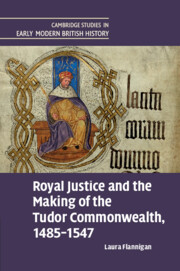Book contents
- Royal Justice and the Making of the Tudor Commonwealth, 1485–1547
- Cambridge Studies in Early Modern British History
- Royal Justice and the Making of the Tudor Commonwealth, 1485–1547
- Copyright page
- Dedication
- Contents
- Figures and Tables
- Acknowledgements
- Note on the Text
- Abbreviations
- Introduction
- Part I The New Justice System
- Chapter 1 The Principle and Problem of Justice
- Chapter 2 Conciliar Justice at Centre and Periphery
- Chapter 3 ‘Travailing between the Prince and Petitioners’
- Part II Seeking and Requesting Justice
- Part III Delivering and Contesting Justice
- Appendix Personnel in the Court of Requests, 1493–1547
- Bibliography
- Index
Chapter 3 - ‘Travailing between the Prince and Petitioners’
The Court of Requests
from Part I - The New Justice System
Published online by Cambridge University Press: 02 November 2023
- Royal Justice and the Making of the Tudor Commonwealth, 1485–1547
- Cambridge Studies in Early Modern British History
- Royal Justice and the Making of the Tudor Commonwealth, 1485–1547
- Copyright page
- Dedication
- Contents
- Figures and Tables
- Acknowledgements
- Note on the Text
- Abbreviations
- Introduction
- Part I The New Justice System
- Chapter 1 The Principle and Problem of Justice
- Chapter 2 Conciliar Justice at Centre and Periphery
- Chapter 3 ‘Travailing between the Prince and Petitioners’
- Part II Seeking and Requesting Justice
- Part III Delivering and Contesting Justice
- Appendix Personnel in the Court of Requests, 1493–1547
- Bibliography
- Index
Summary
By way of a firm case study for the new system of royal justice in action, Chapter 3 provides the first history of the Court of Requests from its initial entry in the historical records in 1483 through to its settlement at Westminster by the end of Henry VIII’s reign. The origin of this tribunal is located in the practice of receiving petitions during royal progresses, particularly in the reign of Richard III. Thereafter, Requests was part of the itinerant household, following Henry VII and Henry VIII as they travelled around their dominions. It only acquired a more defined timetable, judiciary, and seat at Westminster in the 1530s, when it became subject to ministerial reform programmes. Importantly, this evolution to courthood was neither smooth nor linear: its business levels peaked and troughed, it could seemingly always revert to acting on the road, and it was rarely referred to by the name ‘Court of Requests’. With these interpretive challenges in mind, this chapter argues that, contrary to administrative historians’ tendencies to identify positive development in improved bureaucracy, Requests’ flexibility and proximity to the king’s person was advantageous to petitioners.
- Type
- Chapter
- Information
- Publisher: Cambridge University PressPrint publication year: 2023

